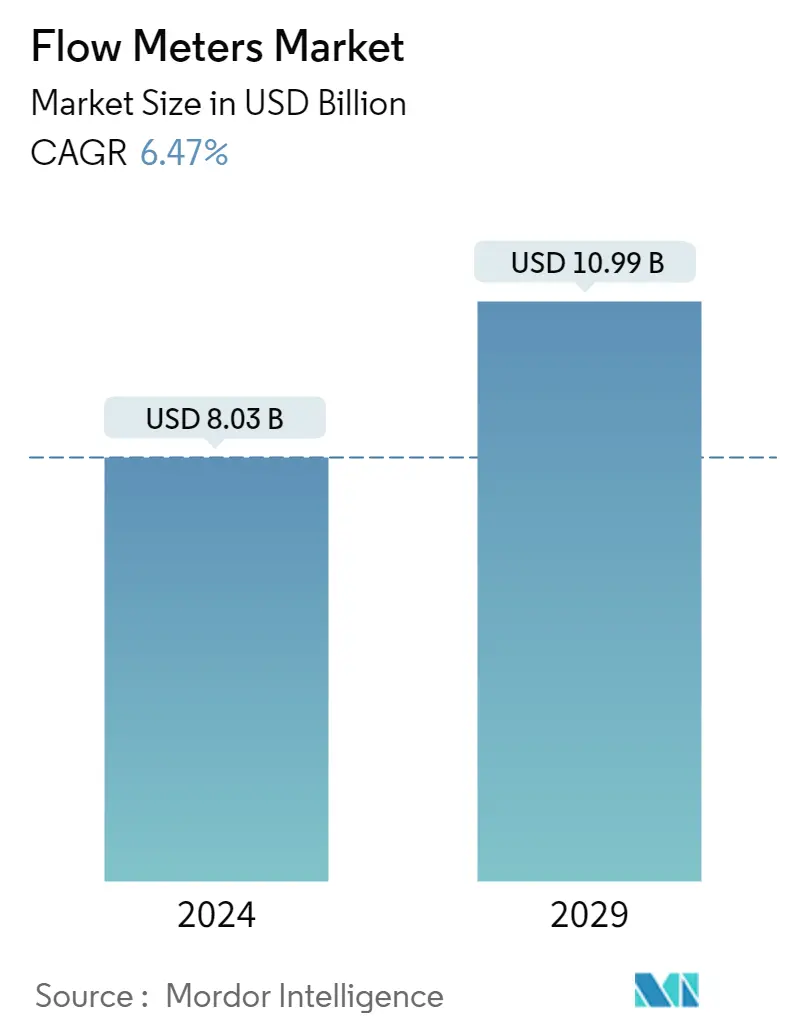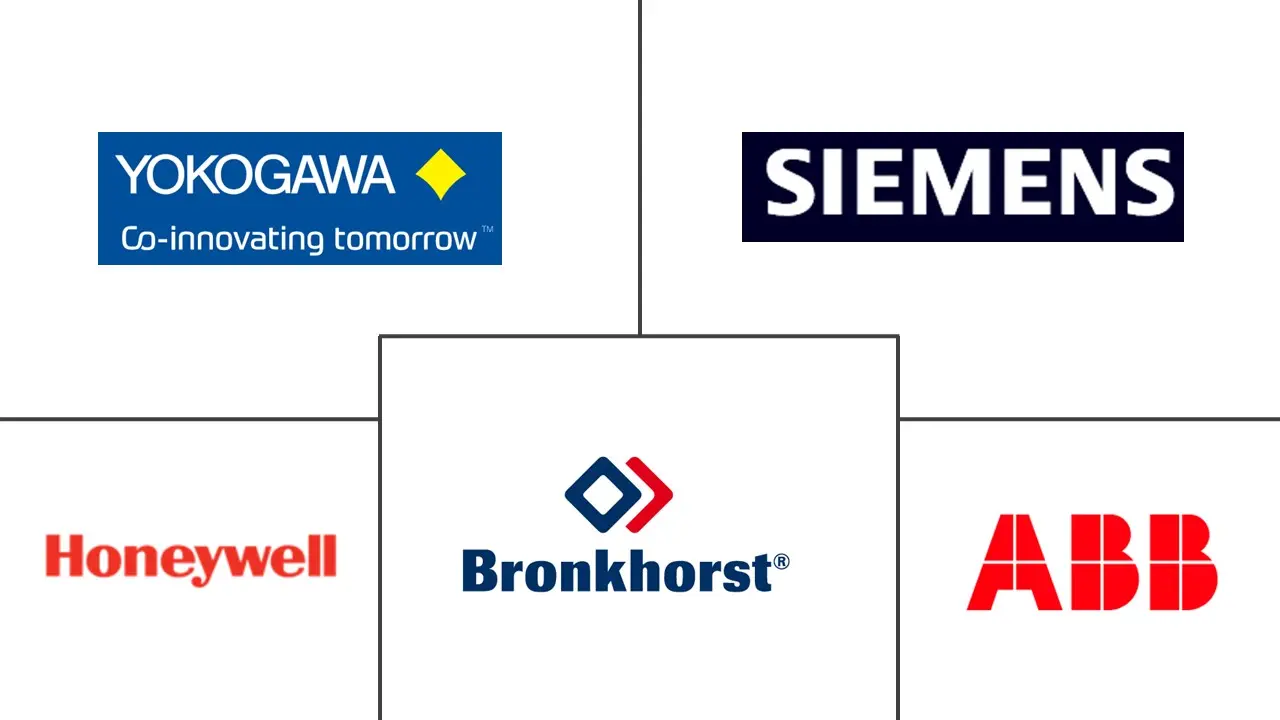Market Size of Flow Meters Industry

| Study Period | 2019 - 2029 |
| Market Size (2024) | USD 8.03 Billion |
| Market Size (2029) | USD 10.99 Billion |
| CAGR (2024 - 2029) | 6.47 % |
| Fastest Growing Market | Asia-Pacific |
| Largest Market | North America |
| Market Concentration | Low |
Major Players
*Disclaimer: Major Players sorted in no particular order |
Flow Meters Market Analysis
The Flow Meters Market size is estimated at USD 8.03 billion in 2024, and is expected to reach USD 10.99 billion by 2029, growing at a CAGR of 6.47% during the forecast period (2024-2029).
Flow meters, called flow sensors, are electronic devices that primarily measure or regulate the flow rate of liquids and gases within pipes and tubes. They are commonly used in HVAC systems, medical devices, chemical factories, and septic systems. These meters can primarily detect leaks, blockages, pipe bursts, and liquid concentration changes owing to contamination or pollution.
- The flow sensors/devices are generally connected to the gauges to render their measurements; however, they can also be connected to computers and digital interfaces. Flow meters can be divided into two groups, contact, and non-contact flow meters. Non-contact flow meters are used when the liquid or gas (generally, a food product) being monitored would be otherwise contaminated or physically altered by coming in contact with the moving parts.
- Multiple emerging technologies, such as IIoT, asset management, and advanced diagnostics, are also helping in forming new collaborations among users and suppliers. Moreover, the strategies for both end users and suppliers have been leveraging advancements in networking and cloud platforms and service offerings that include data and analytics. Flow meters are also witnessing a steady rise in the demand for monitoring and measuring the flow of steam, gas, water, chemicals, and mineral oil, among others. These meters offer essential precision regarding ideal and economic quantity during flow measurement. They offer advantages when it comes to processing control.
- Major trends in flow meter technology include digital signals for flow meters, multiple measurement formats, online diagnosis and troubleshooting, remote calibration and configuration, and smart sensors with online alerts. The technological advancements via robust research and development have also enabled the industry to develop appropriate solutions to complex operational problems. Automated cleaning is also one of the revolutionary trends observed in the market. This trend is advantageous for industries such as water and wastewater management.
- However, certain factors are projected to hinder market expansion. The existing flowmeters in the market are only sometimes compatible with modern machines and infrastructure. Therefore, there is a need to replace the existing outdated versions with newer, efficient, and compatible instruments. The expense of replacing the old instruments with the new generation of equipment might be a costly procedure. This will most certainly limit the market for Flow Meters.
- Industrial sectors, such as oil and gas, chemicals, pulp and paper, and metals and mining, were most affected due by the Covid-19 pandemic, thus witnessing a subsequent decline in the demand for products offered by these industries. However, demand significantly surged in many industrial sectors serving the pharmaceutical, energy, and utility applications. Furthermore, the pandemic also significantly fueled industrial automation adoption, resulting in increased product launches during the pandemic and innovation.
Flow Meters Industry Segmentation
Flow meters (also known as flow sensors) are devices used to measure and record the flow rate. They measure the flow rate of a fluid, liquid, or gas when it passes through a confined transmission system. There are different principles of flow meters, like orifice meters, venturi meters, rotameters, flow nozzles, etc.
The global flow meters market is segmented by technology - Coriolis, differential flow, ultrasonic, vortex, and other technologies. The scope of other technologies covers types like open channel, positive displacement, turbine, variable area, thermal mass, and MEMS.
Different industries, like oil and gas, water and wastewater, paper and pulp, chemical, power generation, and food and beverage, use a flow meter to strengthen their growth rate in their respective fields. End-user industry segment the other end-user industries segment includes semiconductors, HVAC, fuel cells, instrumentation, automotive, and other hazardous areas.
For each segment, the market sizing and forecasts have been provided based on value (in USD million) and volume (in metric tons).
| Technology | |||||
| Coriolis | |||||
| |||||
| Differential Pressure | |||||
| |||||
| Other Technologies |
| End-user Industry | |
| Oil and Gas | |
| Water and Wastewater | |
| Chemical and Petrochemical | |
| Food & Beverage | |
| Pulp and Paper | |
| Other End-user Industries |
| Geography | ||||||
| ||||||
| ||||||
| ||||||
| Latin America | ||||||
| Middle East and Africa |
Flow Meters Market Size Summary
The flow meter market is poised for significant growth, driven by the increasing demand for precise measurement and regulation of liquid and gas flows across various industries. Flow meters, also known as flow sensors, are essential in applications ranging from HVAC systems to chemical factories, offering critical functionalities such as leak detection and flow regulation. The market is characterized by the adoption of advanced technologies like IIoT and digital interfaces, which enhance the capabilities of flow meters by enabling remote monitoring and data analytics. The division between contact and non-contact flow meters caters to diverse industry needs, with non-contact meters being particularly valuable in applications where contamination must be avoided, such as in the food industry. Despite the promising growth trajectory, the market faces challenges, including the need for compatibility with modern infrastructure and the high costs associated with upgrading outdated systems.
The North American region is expected to maintain a substantial market share, supported by its well-established oil and gas, chemicals, and power generation sectors. The renewable energy industry in North America is also anticipated to continue its expansion, further driving the demand for flow meters. Key players in the market, such as Yokogawa Electric Corporation, ABB Ltd, and Siemens AG, are actively engaging in strategic partnerships and product innovations to enhance their offerings and secure a competitive edge. Recent advancements include the introduction of new product lines and software solutions that improve process automation and measurement accuracy. The market's fragmentation is evident with numerous players striving to meet the diverse needs of industries like pharmaceuticals, energy, and utilities, which have seen varying demand fluctuations due to factors like the COVID-19 pandemic.
Flow Meters Market Size - Table of Contents
-
1. MARKET INSIGHTS
-
1.1 Market Overview
-
1.2 Industry Value Chain Analysis
-
1.3 Industry Attractiveness - Porter Five Forces
-
1.3.1 Bargaining Power of Suppliers
-
1.3.2 Bargaining Power of Consumers
-
1.3.3 Threat of New Entrants
-
1.3.4 Threat of Substitute Products
-
1.3.5 Intensity of Competitive Rivalry
-
-
1.4 Recent Technological Developments
-
1.5 Assessment of the Impact of COVID-19 on the Industry
-
-
2. MARKET SEGMENTATION
-
2.1 Technology
-
2.1.1 Coriolis
-
2.1.2 Electromagnetic
-
2.1.2.1 In-line Magnetic Flowmeters
-
2.1.2.2 Low Flow Magnetic Flowmeters
-
2.1.2.3 Insertion
-
-
2.1.3 Differential Pressure
-
2.1.4 Ultrasonic
-
2.1.4.1 Clamp-on
-
2.1.4.2 In-line
-
-
2.1.5 Other Technologies
-
-
2.2 End-user Industry
-
2.2.1 Oil and Gas
-
2.2.2 Water and Wastewater
-
2.2.3 Chemical and Petrochemical
-
2.2.4 Food & Beverage
-
2.2.5 Pulp and Paper
-
2.2.6 Other End-user Industries
-
-
2.3 Geography
-
2.3.1 North America
-
2.3.1.1 United States
-
2.3.1.2 Canada
-
-
2.3.2 Europe
-
2.3.2.1 United Kingdom
-
2.3.2.2 Germany
-
2.3.2.3 France
-
2.3.2.4 Rest of Europe
-
-
2.3.3 Asia Pacific
-
2.3.3.1 China
-
2.3.3.2 Japan
-
2.3.3.3 India
-
2.3.3.4 Rest of Asia Pacific
-
-
2.3.4 Latin America
-
2.3.5 Middle East and Africa
-
-
Flow Meters Market Size FAQs
How big is the Flow Meters Market?
The Flow Meters Market size is expected to reach USD 8.03 billion in 2024 and grow at a CAGR of 6.47% to reach USD 10.99 billion by 2029.
What is the current Flow Meters Market size?
In 2024, the Flow Meters Market size is expected to reach USD 8.03 billion.

